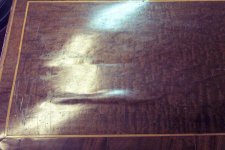I've been asked to repair a ca. 1790 5 drawer chest.
The top is mahogany veneer over an as yet unknown substrate. The veneer in an area of about 8X10 inches has lifted and buckled quite badly and needs to be put back down. The veneer does not appear to be broken, just a very large blister obviously caused by differences in movement between the substrate and the veneer. It appears to be about 1/16 to 3/32 inches thick.
Does anyone have any advice on how this should be approached?
I don't expect the finish to survive but it's not the original finish anyway.
Thanks for any advice. I will try to cross post this in the veneering section.
Herman
The top is mahogany veneer over an as yet unknown substrate. The veneer in an area of about 8X10 inches has lifted and buckled quite badly and needs to be put back down. The veneer does not appear to be broken, just a very large blister obviously caused by differences in movement between the substrate and the veneer. It appears to be about 1/16 to 3/32 inches thick.
Does anyone have any advice on how this should be approached?
I don't expect the finish to survive but it's not the original finish anyway.
Thanks for any advice. I will try to cross post this in the veneering section.
Herman

